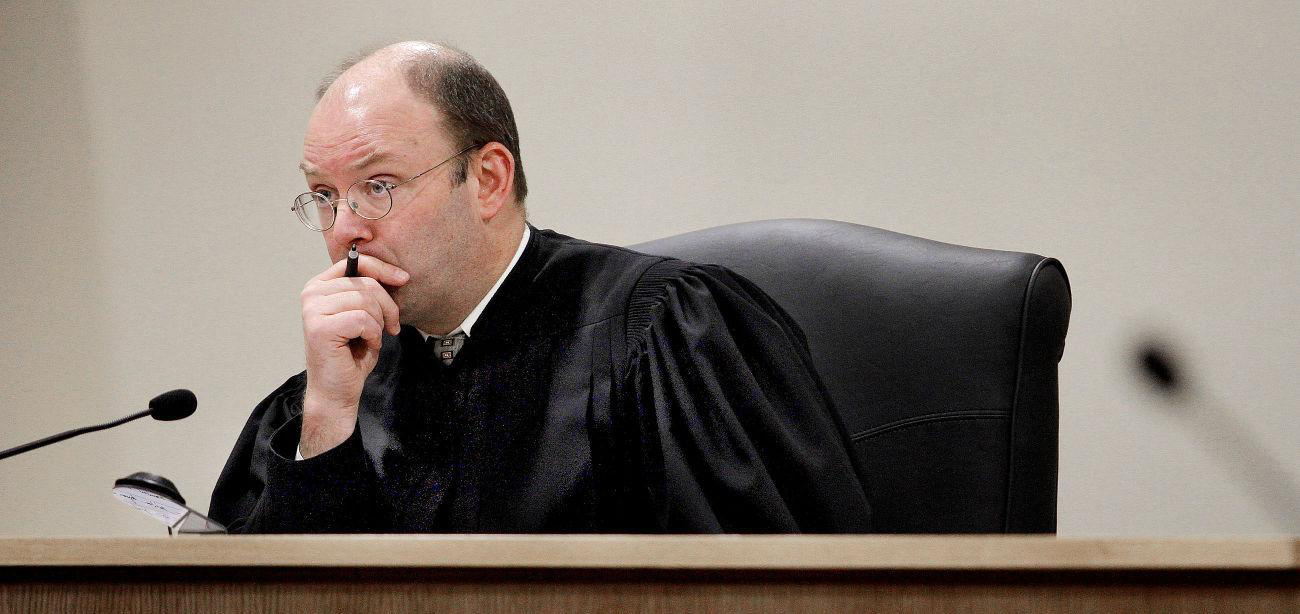State argues plaintiffs ‘confused’ about education tax revenue

Rockingham County Superior Court Judge David Ruoff during court proceedings late last year. (Photo by Michael Moore, Keene Sentinel)The beginning of the school year for New Hampshire students could coincide with rulings that could affect the way the state pays for public education.
Judge David Ruoff of Rockingham County Superior Court, whose docket includes two challenges to the state’s scheme of funding public schools, has indicated that decisions in one or both cases could be forthcoming within 60 days.
In May, Ruoff heard closing arguments in the suit initially filed by the ConVal School District in 2019 claiming that the state has failed to fulfill its constitutional obligation to pay for the adequate education of every child.
Both parties appealed Ruoff’s decision to the state Supreme Court, which in 2021 reversed his order and remanded the case for a second trial, which ended this spring and remains to be decided.
Meanwhile, in June 2022 attorneys Andru Volinsky, John Tobin and Natalie LaFlamme filed suit on behalf of Steven Rand, a business owner from Plymouth, and five other property taxpayers, charging that local school property taxes along with the statewide education property tax, which together fund some 70 percent of education expenditures, are both unconstitutional.
The Rand suit echoes the ConVal suit by claiming the state calculation of the cost of an adequate education is a fraction of its actual cost, leaving local school property taxes to fund the shortfall. However, the ConVal plaintiffs have asked the court to determine the cost of a constitutionally adequate education and provide sufficient funding without directly addressing the issue of taxation.
The Rand plaintiffs claim both local school property taxes and statewide education tax are illegitimate means of funding the state’s obligation to provide constitutionally adequate public education.
Both taxes, the plaintiffs argue, violate the order of the state Supreme Court, which, in the Claremont decision of 1997, held that “To the extent the State relies upon property taxes to fund a constitutionally adequate public education, the tax must be administered in a manner that is equal in valuation and uniform in rate throughout the State.”
Shortly after bringing suit, the Rand plaintiffs filed a motion to enjoin the education tax for the 2023 tax year. Ruoff denied the motion, which he found would disrupt the processes of setting municipal tax rates.
Since then, both the plaintiffs and the state filed motions for summary judgment. Ruoff acknowledged the facts surrounding the administration of the tax are not in dispute, leaving the legitimacy of the tax a matter of law.
“I believe it is ripe for a summary judgment one way or the other,” Ruoff said during a hearing last week.
Education tax measures
The education tax is levied on taxable property throughout the state at a uniform rate to raise $363 million a year. It is collected by municipalities, and the proceeds are appropriated to school districts.
When the tax was first introduced in 1999, receipts in excess of the amount required to fund an adequate education in municipalities with sufficient property wealth were remitted to the state. These funds were then distributed as state aid among municipalities where, for want of sufficient assessed property valuation, returns from the tax failed to meet the cost of an adequate education.
Calling themselves “donor towns,” those with excess education tax formed the Coalition Communities to press the Legislature to abandon what they described as the “donor-receiver” model of school funding. The courts rejected several efforts to spare these municipalities from paying the full rate of the tax by abating or phasing-in the tax. The justices ruled that such measures would reduce the effective rate of the tax below its uniform rate.
Nevertheless, in 2011 the Legislature repealed the requirement to remit excess education tax funds, entitling them to retain any excess “for the use of the school district.”
In FY 2021, 34 municipalities retained $24.4 million in excess education tax funds while in 21 other communities, mostly incorporated places with few if any pupils, the state Department of Revenue Administration set negative local school tax rates to offset the education tax.
According to the education funding plan enacted by the Legislature this year, 43 municipalities will retain $27.3 million in excess education tax revenue, and negative tax rates will be set in seven towns and unincorporated places.
The plaintiffs argue that because the excess education tax revenue and negative tax rates offset the full rate of the tax, the effective rate is not uniform throughout the state as the constitution requires.
Speaking for the plaintiffs, Michael Jaoude of White & Case, LLP of New York, who appeared pro bono, told the court that individual taxpayers, not towns or cities, pay the education tax, adding that as a state tax it must be levied at a uniform effective rate across the state.
Jaoude stressed that the constitutionality of the tax hinges not on its nominal rate but on its effective rate, which represents the actual burden and practical effect on taxpayers. The education tax, he said, fails that test.